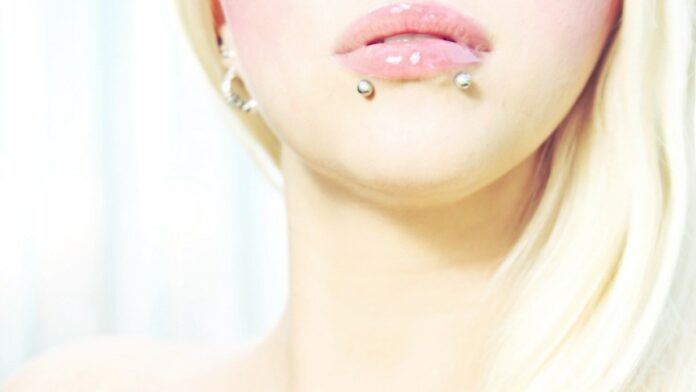Snake Bites Piercing involves having two piercings on the lower lip positioned near its outer corners. This name originates from the resemblance of these piercings to snake fangs when placed side by side.
It’s worth noting that this term might be confusing as there are other similar “bite” piercings, such as spider bites and angel bites.
For greater clarity, you can refer to them as “paired lower lip piercings” if you opt for this style. Lip piercings are favoured due to their versatility, accommodating subtle and bold looks according to your preference. lab
The snakebite piercing falls in between. Despite its name implying a single piercing, it entails two piercings (two side labret piercings on opposite sides of the mouth) that mimic the appearance of snake fangs.
When it comes to the healing process, the snakebite piercing follows a similar path as a side labret piercing (given that it essentially involves obtaining two side labret piercings simultaneously).
However, due to its dual nature, there are additional considerations to bear in mind.
What is Snake Bite Piercing?
First, the term “snakebite” is like a nickname, but professionals prefer “paired lip piercing.” They’ll understand if you ask for a snakebite piercing, but it’s good to know the right word.
The snakebite piercing is under the bottom lip, on each side of the mouth, where side labret piercings go.
It got its name because it looks like snake fangs when you wear hoop jewellery.
You can get both piercings together or, if you already have a side labret piercing, get the other side done for the snakebite look. Some people wait a bit between piercings to heal better.
How Much Does Snake Bite Piercing Hurt?
Everyone feels pain differently, so how much a snakebite piercing hurts can vary. Knowing how well you handle pain can help you get ready.
Getting a snakebite piercing usually feels like a mild pinch in the middle of the pain scale. It’s not too bad, similar to what you might feel if you got your cartilage pierced. But everyone’s different, so it’s hard to say exactly.
Despite how it might look, snakebite piercings aren’t usually as painful as some other lip piercings that go through the lip itself.
People who’ve had this Piercing done often say it’s around a 3 to 5 on a pain scale from 1 to 10, where 10 is the worst. Interestingly, some folks find the clamping part a bit more uncomfortable than the actual Piercing.
What is Snake Bite Piercing Process?
When you go to a piercing studio, you’ll start by discussing the Piercing you want and the jewellery you like. You’ll also fill out some forms, including a waiver.
After that, here’s what happens:
- The piercer will clean the skin around your lower lip.
- You’ll use special mouthwash to get rid of germs in your mouth.
- They’ll mark the spots where the Piercing will be with a pen and make sure you’re okay with it.
- A clamp will hold your lip away from your teeth.
- They’ll use a needle to make the hole for the Piercing, put in the jewellery, and do the same on the other side.
- The piercer will clean the area again to prevent infection.
- They’ll give you instructions on how to take care of your Piercing.
If you’ve had a piercing before, this will be pretty similar. Getting a snakebite piercing is not very different from other piercings.
First, the piercer will clean the spot where the Piercing will be. Then, they’ll mark where the Piercing will go and you’ll confirm it. It’s important to pay attention here, because the snakebite piercing can be placed in different spots on your lower lip.
The piercer might suggest, but you decide. After the marks are okayed, they’ll use something to clean your skin.
When it’s time to do the Piercing, the piercer will tell you how to sit and breathe to make it easier. They’ll quickly put a thin tube through your lip and put the jewellery in. They’ll do the same on the other side.
If this is your first Piercing, it might be quicker and less painful than you think. A good piercer knows how to make it go well and not hurt too much.
Snake Bites Piercing Healing Process
Getting the snakebite piercing is easy; now comes the healing process.
The snakebite piercing takes about four to eight weeks to heal at the very least. But wait for your piercer’s confirmation of complete healing before you stop the aftercare routine, as some people might need more time.
During this time, clean the Piercing 2 to 3 times each day using a piercing aftercare saline solution on both sides of the jewellery.
Generally, it takes about 2 to 3 months to fully heal, depending on how well you follow the aftercare instructions. Other factors like your overall health and the skill of your piercer also affect how long it takes to heal.
Snake Bites Piercing Aftercare
Taking care of your Piercing is very important for it to heal well. Here’s what you should and shouldn’t do during the healing process:
During Healing, DO:
- Wash your hands before touching the Piercing.
- Rinse your mouth with saline solution after eating and before sleeping.
- Clean the outside of the Piercing with saline solution.
- Keep your mouth clean by brushing and flossing regularly.
- Use a soft toothbrush and store it separately.
- Gently clean around the Piercing with mild soap.
- Rinse well to remove soap.
- Pat the area dry with clean paper towels.
- Eat carefully, avoiding hard or spicy foods.
- Reduce swelling by sleeping with your head raised and using cold compresses.
During Healing, DON’T:
- Touch the Piercing with dirty hands.
- Move the jewellery unnecessarily.
- Talk too much, as it can slow healing.
- Chew gum or non-food items.
- Share utensils or engage in oral contact.
- Use alcohol-based mouthwash.
- Smoke, as it can affect healing.
- Go swimming in pools or hot tubs.
- Remove the jewellery before it’s fully healed.
Also, for a while after getting the Piercing, eat soft foods like mashed potatoes and smoothies to prevent accidentally biting the jewellery. Clean the Piercing after eating to remove food bits. If you have double piercings, like snakebite piercings, consider these tips:
- Choose soft foods due to swelling and new jewellery.
- Talk less to help healing, especially for lip piercings.
- Be aware of node and space out piercings if needed.
- Once swelling goes down, ask your piercer for smaller jewellery to avoid biting risks.
Remember, following these steps will help your Piercing heal properly.
Snake Piercing Signs of a problem
During the initial five days, it’s typical to experience swelling, minor bleeding, and tenderness around the piercing area. Additionally, you might observe a slight yellowish discharge from the pierced sites.
However, if you notice any of the following symptoms beyond this initial period, it could indicate a potential problem, such as an infection:
- Severe redness, pain, or significant swelling
- A substantial amount of malodorous discharge that appears thick, green, yellow, or gray
- Development of a rash or formation of blisters near the piercing site
- Skin feeling unusually warm to the touch
- Redness spreading outward from the site of Piercing
- Encountering gum or tooth-related issues like bleeding or erosion
- Experiencing symptoms like fever, chills, vomiting, or confusion
What risks are associated with Snake Bite piercing?
Any time tissue is pierced, there are inherent risks. However, taking proper care afterward and choosing an experienced piercing professional can significantly reduce these risks.
Here are potential issues and effects to be aware of:
Infection
Bacteria can enter through activities like eating, touching your mouth, kissing, or engaging in oral activities, potentially causing an infection.
If the equipment used by the piercing professional isn’t properly sanitized, there’s a risk of contracting bloodborne infections such as tetanus or HIV.
Swelling
Some swelling in the initial days is normal and varies from person to person. Using ice and elevating your head while sleeping can help manage the swelling.
Tooth or Gum Damage
Snake Bite piercing jewellery rubbing against your gums and teeth during talking or chewing can lead to irritation and enamel damage.
Trauma or Tearing
Accidentally catching the lip jewellery on clothing, hair, or during activities like kissing can cause the jewellery to pull, resulting in trauma or tearing.
Nerve Disruption
While rare, a study has linked facial piercings to potential nerve disruption, leading to chronic back pain and even misalignment of the eyes for some individuals.
What material options are available for the jewellery?
When it comes to piercings, the type of material used for your jewellery is essential, especially for mouth piercings where the jewellery can touch your teeth and gums.
For new mouth piercings, it’s recommended to use good-quality metals like implant-grade materials or 14-karat gold and above.
You can choose jewelry made from different materials:
- Surgical steel: This type of jewellery has some nickel, but it usually doesn’t release much nickel, so it’s safe for most people.
- Titanium: Implant-grade titanium doesn’t have nickel and is safe for everyone. It might be more expensive than stainless steel, but it’s better if you’re sensitive to other metals.
- Niobium: This metal is light and affordable, similar to titanium, but without the “implant-grade” label.
- 14-karat or higher gold: If you like gold, make sure it’s real gold, not just coated or filled with gold. Be careful of terms like gold vermeil or overlay, which means other metals under a thin gold layer can chip or wear off.
What Jewellery Can I Wear With My Snake Bite Piercing?
After your Piercing heals completely (and your piercer confirms it), you can have fun choosing new jewelry for your snakebite piercing.
Like a side labret piercing, you can select from various types of snake bite piercing jewelry, including flat back studs, circular barbells, seamless hoops, and captive bead rings.
For studs, picking ones with a flat back is important to prevent irritation against your teeth and gums. This helps avoid wearing down enamel and causing gum issues.
Similarly, if you go for circular barbells or captive bead rings, make sure the ball ends stay on the outer side of your mouth. If they shift inside, you might accidentally bite them and encounter oral problems.
Now that you’re familiar with the snakebite piercing, why not give it a try? With proper care during healing, attention to oral concerns, and finding a skilled piercer, this Piercing could become a stylish part of your look for years to come.
How much does the Snake Bite Piercing usually cost?
The cost can change a lot based on where you are, the kind of jewelry you want, and the experience of the person doing the Piercing.
On average, getting a snake bites piercing usually costs between $60 and $120. Remember, giving a tip of around 20% is normal if you’re happy with the job.
Changing the Jewellrey
Changing the Jewellrey Wait until your Piercing is fully healed before attempting to switch out the jewellery.
Keep in mind that piercings heal from the outer layers inwards, so even if it appears healed on the surface, it might not be internally. If you’re uncertain, seek advice from your piercing professional and let them handle the process for you.
Once the Piercing has completely healed, you can try changing the jewellery yourself. However, if you encounter resistance or difficulty, it’s advisable to seek professional assistance for a smoother transition.
Retiring the Piercing
Ensure you leave the jewellery in place until the Piercing has fully healed, even if you’re not fond of the look.
After the healing period, you can remove the jewellery. During this time, maintain cleanliness around the area as you wait for the hole to close naturally.
Anticipate small scars forming at the piercing sites as the tissue regenerates.
What’s Next
Ready to take the plunge? Research reputable piercing studios with positive reviews and a strong safety track record.
You can seek recommendations from friends and family or locate a credible piercing professional through the Association of Professional Piercers (APP).
Before finalizing your decision, visit the studio in person to:
- Ensure they possess the necessary permits and operating licenses.
- Inquire about their rigorous sterilization procedures.
- Examine their credentials and a portfolio showcasing previous clients’ healed piercings.
- Evaluate the quality of the jewelry they offer.
More Body Piercings
Double Nose Piercing: A Complete Guide
Nose Piercing 101: Everything You Need to Know
Getting Your Ears Pierced at Target (Through Rowan)
Ashley Piercing: Everything You Need to Know About Eye-Catching Lip Piercing
Ashley Piercing Scar: Every Thing you Need to know About Ashley Piercing Scarring
The Labret Piercing: Everything You Need To Know
Everything You Need to Know About Vertical Labret Piercing
Do You Want a Bottom Lip Piercing?: A Complete Guide
Conclusion
The snakebite piercing involves two lower lip piercings, resembling snake fangs. It’s prudent to refer to them as “paired lower lip piercings” to avoid confusion with similar “bite” piercings. Lip piercings offer versatile aesthetics.
The snakebite piercing’s healing process mirrors side labret piercings but requires extra care due to its dual nature. Pain perception varies, with most rating it around 3 to 5 on a scale of 1 to 10.
Healing takes 4 to 8 weeks, with full healing in 2 to 3 months. Proper aftercare is vital, as is recognizing red flags. Risks include infection, swelling, tooth/gum damage, trauma, and nerve disruption. Choose implant-grade metals or 14-karat gold for jewelry.
FAQs Snake Bite Piercing
Question: How painful are snake bite piercings?
Answer: Snake bite piercings, also known as paired lower lip piercings, are generally not as painful as other lip piercings that go through the lip itself.
On a pain scale of 1 to 10, with 10 being the highest, those who’ve had snake bite piercings done usually rate the pain around 3 to 5. Interestingly, many individuals find the clamping sensation during the procedure to be more uncomfortable than the actual Piercing.
Question: Do snake bite piercings damage teeth?
Answer: Yes, snake bite piercings can potentially harm your teeth. These jewelry pieces come with various risks to both your oral and overall health.
Medical studies have linked snake bite piercings to higher instances of gum disease, gum recession, tooth decay, and even cracked or chipped teeth. Additionally, they are susceptible to infections and could lead to nerve damage in the face or tongue.
Question: Can you kiss after getting a snake bite piercing?
Answer: It’s recommended to avoid kissing or engaging in oral activities for at least three weeks after getting a snake bite piercing. To prevent infection, it’s important not to pick at any scabs that may form around the piercing area.
Additionally, refraining from smoking and alcohol consumption during this period is advised. These precautions contribute to a healthier healing process for your Piercing.
Question: Is snake bite piercing tongue risky?
Answer: It’s considered a fad piercing, and, as with most fad piercings, there are multiple risks involved with it. There’s a high risk of rejection and cracking or chipping of the teeth.
The tongue consists of two muscles connected by the Piercing, preventing independent movement.




